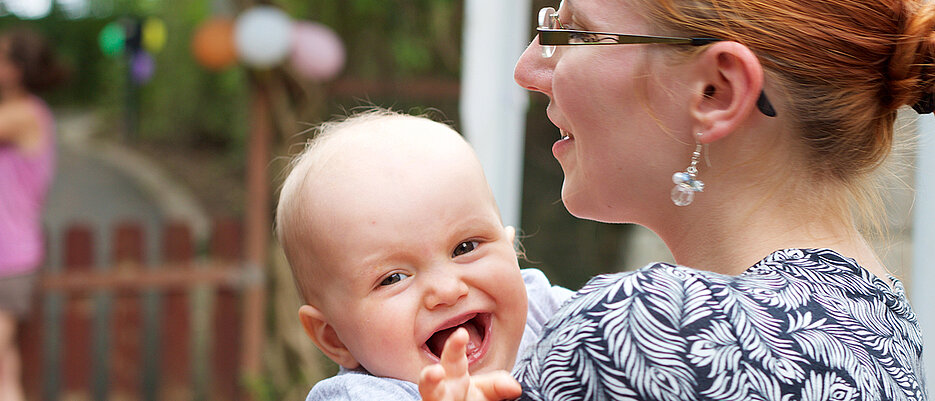From melody to language
02/18/2021In the process of developing language, the melody patterns that emerge in infants' vocalisations are a very important first step. A new study has shown that the complexity of these patterns rapidly increases in the first months.

In the first few months of their lives, babies cry, babble, gurgle and make a variety of other peculiar sounds. It can be difficult to imagine that they are actually laying the foundations for later speech with these utterances. However, there is a determining element that proves that even their cries can be assigned to a particular language: the speech melody – or, more accurately: prosody.
"Every language is characterised by specific musical elements, which we call prosody," says Kathleen Wermke. Prosody, in simple terms, is the combination of intonation (melody) and rhythm. Earlier studies have shown that even newborns are able to distinguish different languages, like German or French, using prosodic cues, particularly melody. With the help of these musical elements, infants recognise the respective language long before they are able to perceive its special features such as consonants, vowels or syllables.
Study with more than 67,000 baby sounds
Kathleen Wermke is a Professor at the Würzburg University Hospital at the Department of Orthodontics and Head of the Center for Pre-speech Development and Developmental Disorders. Together with scientists from the USA and New Zealand, she has now examined the vocalisations of a total of 277 infants over the first six months of life in more detail. In total, the team analysed more than 67,500 cry vocalisations – the so-called hungry-crying -, cooing and babbling sounds.
"We have found a clear developmental pattern towards more complexity," Wermke summarises the result of the study, which has now been published in the journal Scientific Reports. According to the study, this increasing degree of complexity is an important building block on the way to language development. According to the research team, these findings do not only significantly improves our understanding of the early preparatory processes for language acquisition, it also makes it possible to identify potential signs of a language development disorder.
Complexity increases over the course of the first six months
In their study, the team distinguished between two types of vocalisations in babies: cry and non-cry vocalisations in technical language. Or, to put it another way, the "communicative" crying uttered in the presence of the mother, which results from discomfort such as hunger and when there is a desire for contact. And, on the other hand, the sounds a baby makes when it feels comfortable and interacts vocally. "The aim of the study was to conduct an objective developmental analysis of prosodic antecedents in the form of melodies in healthy infants from birth to 6 months of age in all their vocalisations," says Wermke. Her hypothesis was: both types of vocalisation show a characteristic developmental increase in complex melodies.
In fact, the evaluation shows that the melodies of spontaneous cries become increasingly complex during the first 180 days of life; complex meaning that simple melodies (single-arc) are increasingly replaced by multiple-arc melodies, i.e. the foundation for the richness of variants of later intonation patterns in speech is already laid during crying. The development was comparable for phonetic utterances that fall under the category of "comfort vocalisations". The degree of complexity also increased in these, but with a temporary decline at around 140 days of age.
Rapid brain growth is the foundation
"Already at the end of the first month of life, the cry repertoire of the babies studied shows a complex melody in more than half of the cases," says Wermke. From single-arc to multiple-arc melodies in 30 days: this developmental programme is based on an early maturity of the neurophysiological mechanisms underlying melody production. In fact, the brains of newborns also grow tremendously fast during this time, and newborns show amazing coordination between breathing and phonation. Furthermore, the scientists believe that the early occurrence of complex cry melodies indicates that infants have already undergone a kind of training, a "preparatory" intrauterine development before birth, in order to start with the development of melodies immediately after or at the starting signal "birth".
Wermke and her co-authors have an explanation for this slight decrease in complexity between the ages of four and five months: "During this time, infants expand their repertoire of vocalic utterances to include new components that interact with the overall melodic contour, namely vowel- and consonant-like elements," says Kathleen Wermke. At the same time, the larynx and vocal tract are changing, which entails a series of adaptation processes in sound production. In addition to this, infants also begin to produce their first syllable combinations in babbling during this phase. "This new developmental period evidently causes a temporary 'regression' in melody development to establish vocal development on a higher hierarchical level. Thereafter, the infant begins to intentionally imitate intonation patterns of the surrounding language(s) in consonant-vowel syllable sequences in babbling.
Prerequisite for innovative therapies
According to those involved, the developmental model now presented can contribute to a better understanding of why the human infant acquires such a complex skill as language so quickly and seemingly effortlessly. What sounds like rather dry basic research in the field of spoken language acquisition nevertheless has a very practical relevance. "Knowledge of this developmental process will enable us to identify clinically robust risk markers for language development disorders," says Wermke. This, she says, is the crucial prerequisite for developing new and innovative therapies for young children at risk for language disorders.
Original publication
Melody complexity of infants’ cry and non-cry vocalisations increases across the first six months. K. Wermke, Michael P. Robb, Philip J. Schluter. Scientific Reports. DOI: 10.1038/s41598-021-83564-8
Contact
Prof. Dr. Kathleen Wermke, Center for Pre-speech Development and Developmental Disorders,
T: +49 931 201 73 430; Wermke_K@ukw.de






